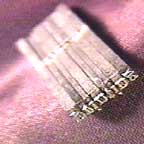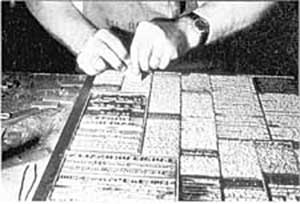NOTE: You may also like to read our article on Typography concepts and website typography.
Since printing and type was invented, fonts have taken several physical forms including ...
- Carved wooden blocks (ink was added and the paper pressed against them)
- Cast metal type (again ink was added and the paper pressed against them)
- Transparent film negatives (through which light was shone onto photographic paper)
- Digital files (computer system fonts)
A word composed from metal type

A metal type font collection

Hand setting rows of metal type

Digital fonts (computer system fonts)
Today, fonts are computer operating system level files/resources, used by the operating system, applications and files to style and display text. Fonts must be installed on a computer's start-up disk if they are to be loaded with the system during booting and become available for use by applications and files.
For example, when you compose a letter in a word processing application, you will probably choose a typographical style for your text from a drop down menu or style dialogue box. When you save your letter, although the font itself is not saved, the file will contain instructions to display the text with the chosen font when the file is next opened. If you subsequently delete the chosen font from your start-up disk, or move the letter to another computer that does not have the font, the system will warn you and ask you to substitute an alternative font.
Font types
Computer font technology is always improving and changing. At present these are the leading font technologies ...
- Adobe PostScript Type 1
- Adobe multiple masters
- True Type (.ttf)
- OpenType (.otf)
- Embedded OpenType (.eot), used by IE for the @font-face CSS method
- Scalable Vector Graphics (.svg), use by iOS versions pre 4.2
Adobe PostScript Type 1
Before OpenType fonts, professional graphic designers used to only use PostScript fonts. Professional output devices (such as a high quality computer printer, a digital colour printer at an image bureau, or an image setter) like PostScript fonts.
PostScript fonts have two parts. The first part is the Bitmapped Screen Font which lives in a Suitcase folder and is used by your OS to display the fonts on screen as you create your artwork. The second part is the Outline Printer Font which consists of PostScript outlines that describe the character shapes. This is the part needed by the output device.
![]()
Note: A small system utility/extension called Adobe Type Manager (ATM) was released in 1989. It created bitmapped fonts in real time, thus allowing designers to see fonts on screen at any size. If you have Adobe Type Manger (ATM) installed on your computer you will be able to print PostScript fonts on you inkjet and display a PostScript Outline Printer Font on-screen without its Bitmapped Screen Font.
There are other PostScript fonts types but only type 1 became popular and widely used.
True Type
True Type fonts do not require ATM, have only one part, the Printer Outline Font, and are scalable thus allowing any size to be realised from a single font file. The OS knows how to create on-screen versions on the fly so you don't need bitmapped screen versions. Domestic output devices which don't support PostScript, such as desktop inkjet printers, prefer True Type.
The problem with TrueType is that Mac TrueType fonts aren't compatible with Windows TrueType fonts and freed from Adobe's licensing restrictions the marketplace became flooded with poorly designed amateur fonts undermining the technologies reputation. Professional graphic designers avoid TrueType fonts despite the fact that the format is as robust as PostScript.
Adobe multiple masters
Intended as a replacement for PostScript, multiple masters failed in the marketplace and was discontinued in the late 1990s. Its primary advantage was the ability to create multiple instances of different styles (bold, italic etc) from a single font file.
OpenType fonts
Because of compatibility issues between Macs, Windows and Unix computers, Adobe and Microsoft have developed the OpenType font format. Here are the essential points taken from www.desktoppub.com ...
- The same OpenType font file works on both Mac and PC.
- An extension of the TrueType format with Unicode based character coding, OpenType can also include PostScript font data.
- In Windows, OpenType fonts can have an .otf or .ttf suffix. The .otf fonts are ones that contain PostScript data.
- Each OpenType font has a single font file containing all information about that font.
- OpenType, PostScript Type 1, and TrueType fonts can all reside on the same system.
- Unlike the PostScript Type 1 font limit of around 256 glyphs, OpenType fonts may contain thousands of glyphs and eliminating the need for separate fonts for ligatures, small caps, different language character sets, and other Expert Character sets & it's all in one font file.
- The .otf version of OpenType fonts use a compact font format that results in relatively smaller font file sizes, despite packing in more glyphs and other data.
- Adobe finished converting its entire PostScript library to TrueType in 2003.
Which font types should I use?
If you are a graphic designer you should continue to use the PostScript fonts which you own but consider buying OpenType fonts in future. However, you should check that the software and printers you use support OpenType.
If you are a web or multimedia designer who produces work just for the screen, then any font type will probably be OK providing you understand the processes of embedding and linking (discussed below).
If you are buying fonts for the first time, you should consider OpenType.
Fonts for repro
Send a page layout file (Quark, InDesign etc)
When artwork layout is complete, a folder must be created containing the page layout file and a folder of images it contains. You should also consider including a folder containing the fonts you have used although for licensing reasons moving fonts between computers is illegal. You must therefore rely on the image bureau or printer who is going to output your artwork to have these same fonts on their system. In practice, your printer will probably ask you to include a folder of fonts, just in case.
PDFs
An alternative to this system is to output your artwork as a 300dpi / CMYK Acrobat PDF file. PDF files can embed images and fonts. This has become the favoured method for delivering artwork for print.
Fonts for multimedia & web sites
When authoring cross platform multimedia and web site projects a developer cannot assume that his or her chosen fonts will be installed on the end-user's system. A developer may employ several strategies to resolve font differences between platforms.
Using System (web safe) fonts only
When creating word processing, spreadsheet documents etc and styling HTML text for web pages, it is best to only use fonts which you are certain will be installed on an end-user's system, such as system default fonts. There is a small range of font families that you can expect to be installed on all computers. The most commonly used are ...
- Times New Roman, Times
- Arial and Helvetica
- Courier
- Verdana
More on web typography and fonts is here.
Embedding fonts
If you want to use specialist fonts then you will need to embed them into documents to ensure text will styled and display as you want. Here are some ways to embed ...
Images
If you create text in a pixel based image editor such as Photoshop, or in Director's Paint Window, it will automatically be converted into bitmapped images. The disadvantage is that if you need to edit your words you'll have to go back to the original image file. Fonts in vector programs such as Adobe Illustrator will not be embedded in files unless you save the image in a bitmap format (JPEG, PICT etc) or convert text to outlines.
Director/Shockwave
You can embed fonts in a Director movie.
Flash
You can embed fonts in Flash files.
Acrobat PDFs
You can embed fonts in PDFs.
